Abstract
Inadequate penetration of antiviral agents through the stratum corneum of the skin may be one of the limiting factors in the topical therapy of recurrent cutaneous herpes simplex virus infections in humans. In vitro studies of the penetration of the nucleoside analog acyclovir (ACV) through guinea pig skin demonstrated a marked increase in drug flux when ACV was formulated in dimethyl sulfoxide (DMSO), compared with water or polyethylene glycol (PEG) as the vehicle. To examine whether the increased transcutaneous flux of ACV effected by DMSO was meaningful in vivo, topical 5% ACV in DMSO was evaluated for the treatment of cutaneous herpes simplex virus infection in guinea pigs and compared with topical 5% ACV in PEG. When compared with infection sites treated with the vehicle alone, ACV in DMSO produced a greater percent reduction than did ACV in PEG in median lesion number (8 versus 58%; P less than 0.001), median lesion area (35 versus 73%; P = 0.001), and median lesion virus titer (21 versus 84%; P = 0.08). We conclude that DMSO is a highly effective vehicle for topical administration of ACV and is superior to PEG in our model. Careful choice of vehicle and consideration of transcutaneous penetration may be important for realization of the full potential of topical antiviral therapy in humans.
Full text
PDF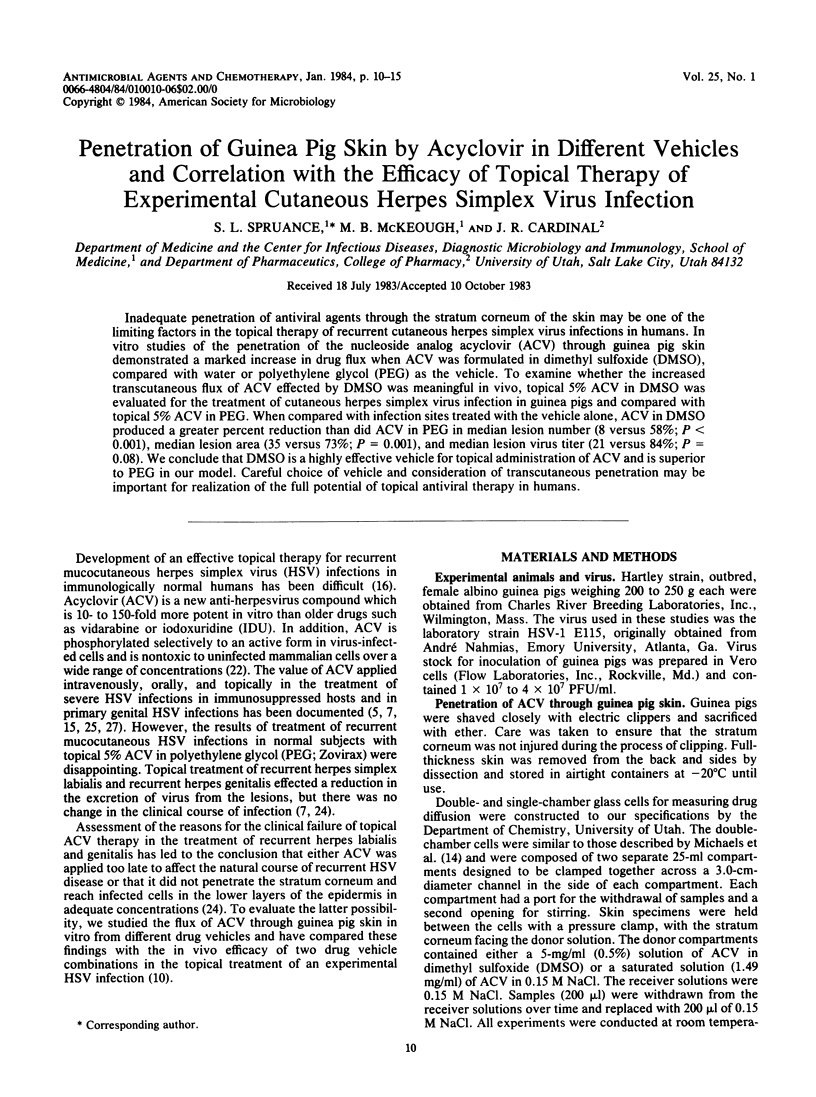
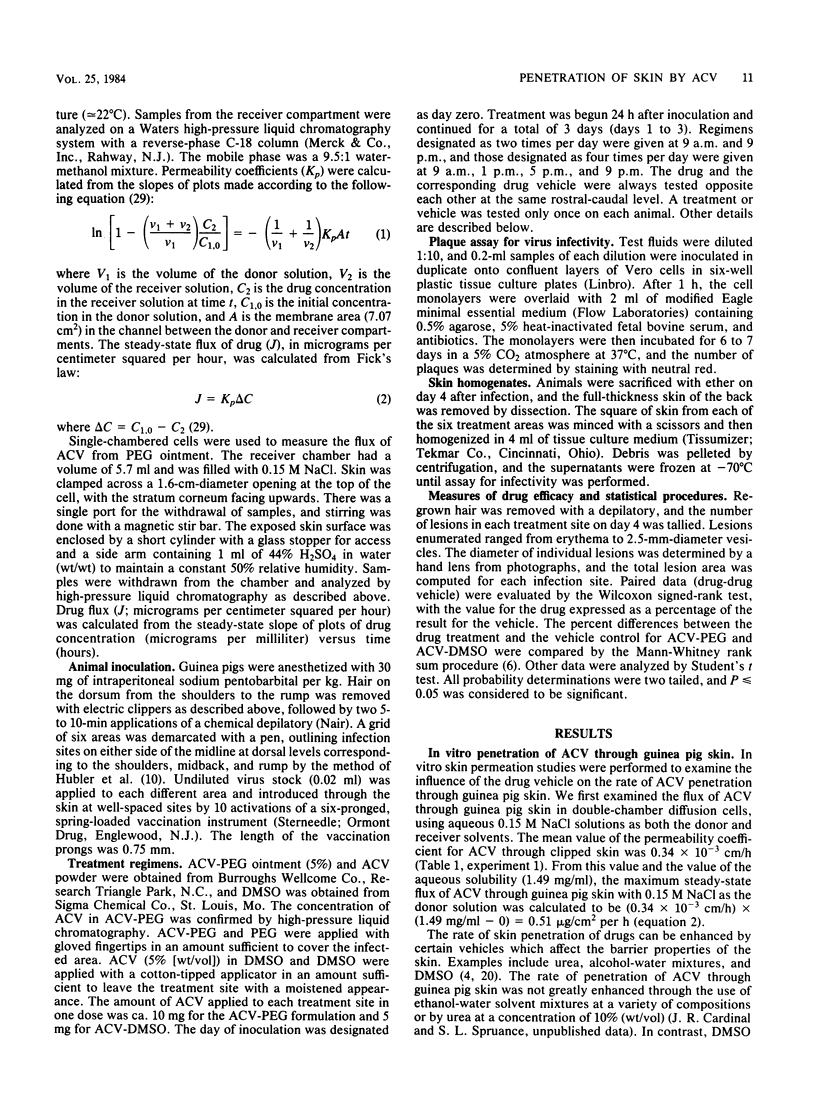
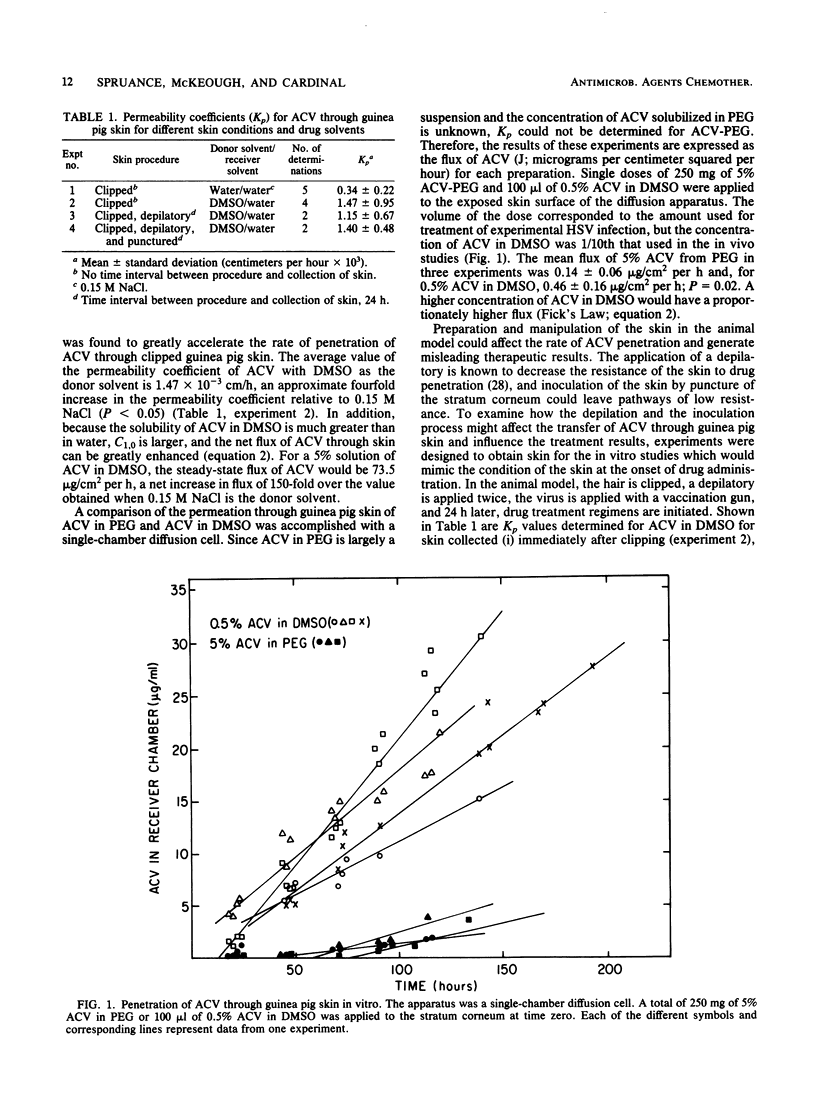
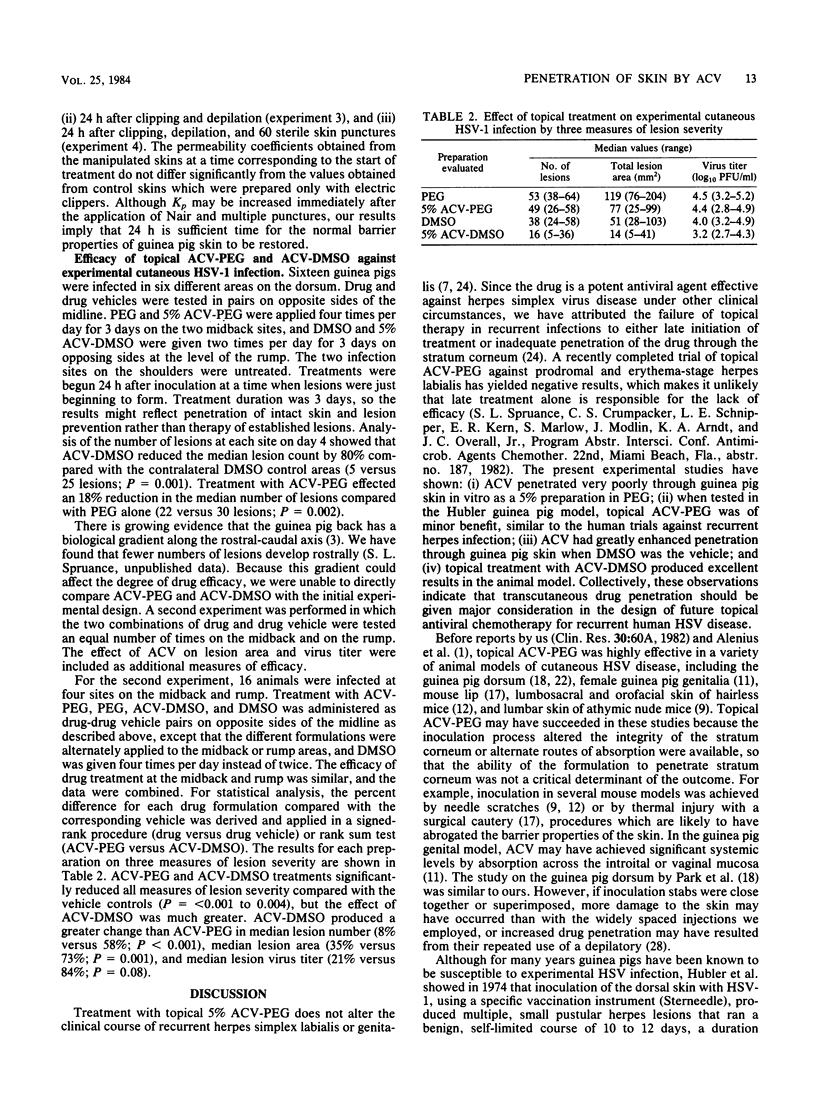
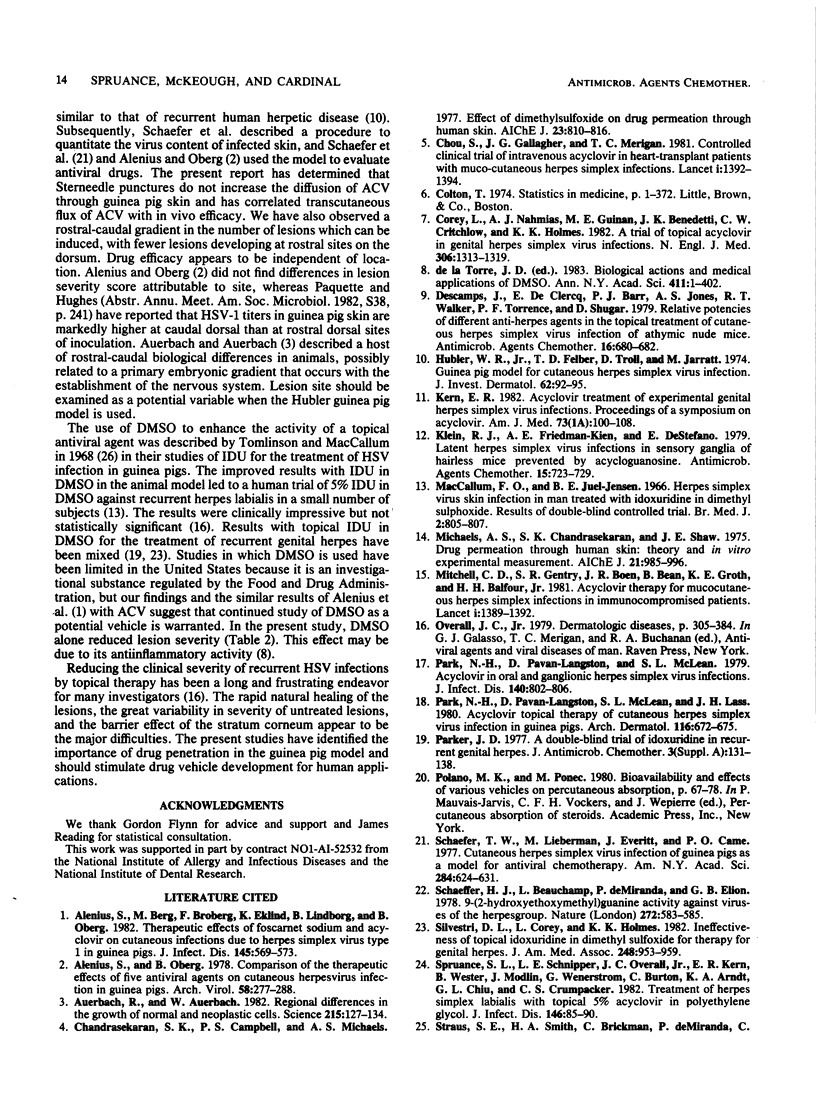
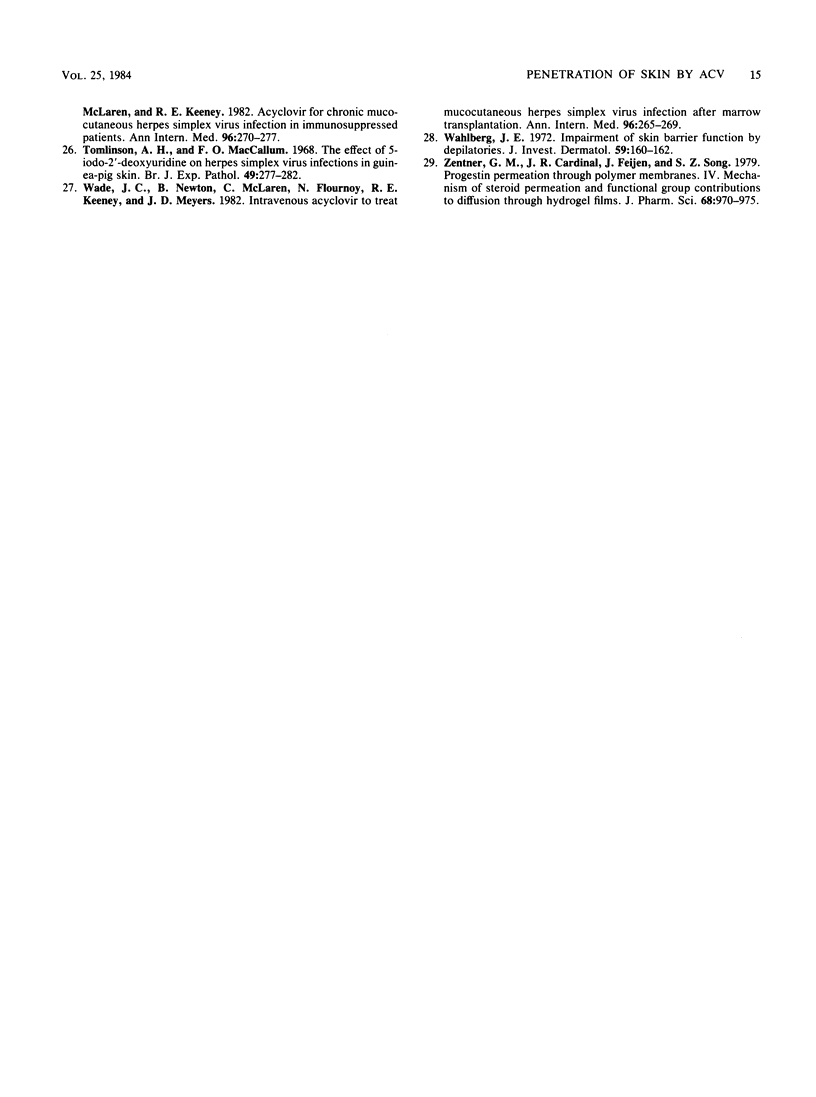
Selected References
These references are in PubMed. This may not be the complete list of references from this article.
- Alenius S., Berg M., Broberg F., Eklind K., Lindborg B., Oberg B. Therapeutic effects of foscarnet sodium and acyclovir on cutaneous infections due to herpes simplex virus type 1 in guinea pigs. J Infect Dis. 1982 Apr;145(4):569–573. doi: 10.1093/infdis/145.4.569. [DOI] [PubMed] [Google Scholar]
- Alenius S., Oberg B. Comparison of the therapeutic effects of five antiviral agents on cutaneous herpesvirus infection in guinea pigs. Arch Virol. 1978;58(4):277–288. doi: 10.1007/BF01317820. [DOI] [PubMed] [Google Scholar]
- Auerbach R., Auerbach W. Regional differences in the growth of normal and neoplastic cells. Science. 1982 Jan 8;215(4529):127–134. doi: 10.1126/science.7053564. [DOI] [PubMed] [Google Scholar]
- Chou S., Gallagher J. G., Merigan T. C. Controlled clinical trial of intravenous acyclovir in heart-transplant patients with mucocutaneous herpes simplex infections. Lancet. 1981 Jun 27;1(8235):1392–1394. doi: 10.1016/s0140-6736(81)92570-8. [DOI] [PubMed] [Google Scholar]
- Corey L., Nahmias A. J., Guinan M. E., Benedetti J. K., Critchlow C. W., Holmes K. K. A trial of topical acyclovir in genital herpes simplex virus infections. N Engl J Med. 1982 Jun 3;306(22):1313–1319. doi: 10.1056/NEJM198206033062201. [DOI] [PubMed] [Google Scholar]
- Descamps J., De Clercq E., Barr P. J., Jones A. S., Walker R. T., Torrence P. F., Shugar D. Relative potencies of different anti-herpes agents in the topical treatment of cutaneous herpes simplex virus infection of athymic nude mice. Antimicrob Agents Chemother. 1979 Nov;16(5):680–682. doi: 10.1128/aac.16.5.680. [DOI] [PMC free article] [PubMed] [Google Scholar]
- Hubler W. R., Jr, Felber T. D., Troll D., Jarratt M. Guinea pig model for cutaneous herpes simplex virus infection. J Invest Dermatol. 1974 Feb;62(2):92–95. doi: 10.1111/1523-1747.ep12692222. [DOI] [PubMed] [Google Scholar]
- Kern E. R. Acyclovir treatment of experimental genital herpes simplex virus infections. Am J Med. 1982 Jul 20;73(1A):100–108. doi: 10.1016/0002-9343(82)90073-0. [DOI] [PubMed] [Google Scholar]
- Klein R. J., Friedman-Kien A. E., DeStefano E. Latent herpes simplex virus infections in sensory ganglia of hairless mice prevented by acycloguanosine. Antimicrob Agents Chemother. 1979 May;15(5):723–729. doi: 10.1128/aac.15.5.723. [DOI] [PMC free article] [PubMed] [Google Scholar]
- MacCallum F. O., Juel-Jensen B. E. Herpes simplex virus skin infection in man treated with idoxuridine in dimethyl sulphoxide. Results of double-blind controlled trial. Br Med J. 1966 Oct 1;2(5517):805–807. doi: 10.1136/bmj.2.5517.805. [DOI] [PMC free article] [PubMed] [Google Scholar]
- Mitchell C. D., Bean B., Gentry S. R., Groth K. E., Boen J. R., Balfour H. H., Jr Acyclovir therapy for mucocutaneous herpes simplex infections in immunocompromised patients. Lancet. 1981 Jun 27;1(8235):1389–1392. doi: 10.1016/s0140-6736(81)92569-1. [DOI] [PubMed] [Google Scholar]
- Park N. H., Pavan-Langston D., McLean S. L. Acylovir in oral and ganglionic herpes simplex virus infections. J Infect Dis. 1979 Nov;140(5):802–806. doi: 10.1093/infdis/140.5.802. [DOI] [PubMed] [Google Scholar]
- Park N. H., Pavan-Langston D., McLean S. L., Lass J. H. Acyclovir topical therapy of cutaneous herpes simplex virus infection in guinea pigs. Arch Dermatol. 1980 Jun;116(6):672–675. [PubMed] [Google Scholar]
- Parker J. D. A double-blind trial of idoxuridine in recurrent genital herpes. J Antimicrob Chemother. 1977 Mar;3 (Suppl A):131–137. doi: 10.1093/jac/3.suppl_a.131. [DOI] [PubMed] [Google Scholar]
- Schaeffer H. J., Beauchamp L., de Miranda P., Elion G. B., Bauer D. J., Collins P. 9-(2-hydroxyethoxymethyl) guanine activity against viruses of the herpes group. Nature. 1978 Apr 13;272(5654):583–585. doi: 10.1038/272583a0. [DOI] [PubMed] [Google Scholar]
- Schafer T. W., Lieberman M., Everitt J., Came P. Cutaneous herpes simplex virus infection of guinea pigs as a model for antiviral chemotherapy. Ann N Y Acad Sci. 1977 Mar 4;284:624–631. doi: 10.1111/j.1749-6632.1977.tb21996.x. [DOI] [PubMed] [Google Scholar]
- Silvestri D. L., Corey L., Holmes K. K. Ineffectiveness of topical idoxuridine in dimethyl sulfoxide for therapy for genital herpes. JAMA. 1982 Aug 27;248(8):953–959. [PubMed] [Google Scholar]
- Spruance S. L., Schnipper L. E., Overall J. C., Jr, Kern E. R., Wester B., Modlin J., Wenerstrom G., Burton C., Arndt K. A., Chiu G. L. Treatment of herpes simplex labialis with topical acyclovir in polyethylene glycol. J Infect Dis. 1982 Jul;146(1):85–90. doi: 10.1093/infdis/146.1.85. [DOI] [PubMed] [Google Scholar]
- Straus S. E., Smith H. A., Brickman C., de Miranda P., McLaren C., Keeney R. E. Acyclovir for chronic mucocutaneous herpes simplex virus infection in immunosuppressed patients. Ann Intern Med. 1982 Mar;96(3):270–277. doi: 10.7326/0003-4819-96-3-270. [DOI] [PubMed] [Google Scholar]
- Tomlinson A. H., Maccallum F. O. The effect of 5-iodo-2'-deoxyuridine on herpes simplex virus infections in guinea-pig skin. Br J Exp Pathol. 1968 Jun;49(3):277–282. [PMC free article] [PubMed] [Google Scholar]
- Wade J. C., Newton B., McLaren C., Flournoy N., Keeney R. E., Meyers J. D. Intravenous acyclovir to treat mucocutaneous herpes simplex virus infection after marrow transplantation: a double-blind trial. Ann Intern Med. 1982 Mar;96(3):265–269. doi: 10.7326/0003-4819-96-3-265. [DOI] [PubMed] [Google Scholar]
- Wahlberg J. E. Impairment of skin barrier function by depilatories. J Invest Dermatol. 1972 Aug;59(2):160–162. doi: 10.1111/1523-1747.ep12625943. [DOI] [PubMed] [Google Scholar]
- Zentner G. M., Cardinal J. R., Feijen J., Song S. Z. Progestin permeation through polymer membranes IV: Mechanism of steroid permeation and functional group contributions to diffusion through hydrogel films. J Pharm Sci. 1979 Aug;68(8):970–975. doi: 10.1002/jps.2600680814. [DOI] [PubMed] [Google Scholar]


